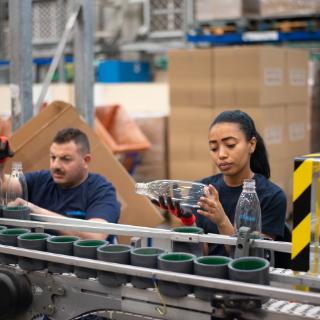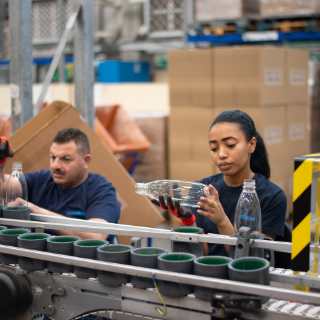Prevent It


5 Early Intervention Tips to Prevent Manufacturing Injuries
With fast-moving assembly lines and hazardous work environments, the typical manufacturing facility exposes employees to numerous potential injury risks. These manufacturing injuries can be surprisingly similar, whether the company produces widgets, medical instruments, or canned fruit. According to the Bureau of Labor, the most common injuries in the manufacturing industry include:
-
Overexertion – Musculoskeletal disorders (MSDs) are prevalent because the work often requires physical tasks such as heavy lifting.
-
Repetitive motion – Factory workers repeatedly performing the same movement can develop repetitive strain injuries. The body’s soft tissues start to wear down.
-
Body movement injuries – Many injuries occur because the worker is continuously bending, crawling, twisting, and reaching in awkward positions.
Of course, nobody wants to see an employee injured on the job. Employees in pain can’t work as effectively as before, or perhaps not at all, potentially causing missed production deadlines and unhappy customers. Also, workplace injury claims are expensive, not to mention bad for both employee morale and the bottom line.
However, there are concrete steps manufacturers can take to keep their workforce healthy and productive. With proactive measures such as Early Intervention programs, trained clinicians can pre-emptively treat manufacturing injuries or even prevent them from ever happening.
How Early Intervention Programs Improve Worker Wellbeing
Early intervention programs featuring onsite physical therapy services by a Physical Therapist/Occupational Therapist (PT/OT) can significantly reduce the number and impact of musculoskeletal workplace injuries. By interacting directly with the employees, the onsite PT/OT becomes a trusted, familiar face who can proactively engage with those at risk, training them to perform their jobs safely.
The goal is to help employees avoid manufacturing injuries in the first place and address the worker’s reported discomfort early on, before the need for medical attention, diagnosis and/or treatment. Onsite early intervention programs are effective because, once the PT/OT is familiar with the employee challenges and their work environment, they can shift the focus from treating manufacturing injuries to prevention.
The Onsite PT Becomes a Trusted Employee Advocate
With an onsite Early Intervention Program, the employees know who to see about manufacturing injuries or discomfort, and they become comfortable speaking with PT’s about their issues. Trained staff can also examine the root cause of the employee’s pain and ensure corrective actions are taken to prevent further discomfort or injury. PTs can also engage with employees one-on-one and coach them on proper work techniques such as lifting ergonomics.
Early intervention onsite services help workers with new injuries stay on the job. They can enable continued employment for workers experiencing a worsening chronic condition that could limit their capacity or even cause them to leave the workforce.
Here are five examples of how onsite PT’s can engage with workers on a regular basis.
- Walk the floor, talk with employees, and watch their movements as they perform their jobs. This real time feedback prevents injuries.
- Deliver educational “Lunch and Learn” programs on manufacturing injury risk factors and prevention techniques.
- Conduct regular stretching exercise programs and postural awareness sessions to teach employees how to move safely and correctly position their bodies.
- Participate in onsite Health Fairs and deliver information on the safety and wellbeing of employees. More awareness helps your workforce understand wellness principles and the value of early detection and treatment of pain issues.
- Keep onsite PT and safety front of mind with short videos and tip sheets displayed in employee common areas.
Benefits of Early Intervention – Fewer injuries, fewer claims
Program success is all about employee engagement. PTs proactive walking the floor and engaging with employees., seeking out new employees and ensuring they are performing movements correctly, and making the physical therapist part of the team helps create employee trust and confidence.
This can reinforce a positive safety culture that keeps employees healthy and on the job. And fewer expensive worker compensation claims can significantly reduce a company’s overall costs.
At Workwell, we’re a worldwide industry leader who delivers training, coaching, and education services focused on workplace injury prevention.
Learn more about manufacturing ergonomics in the following posts:
- Boost Your Ergonomics Committee's Impact
- Industrial Ergonomic Assessments - How to Get the Best Value from Them
- WorkWell Unveils New Ergonomics On-Demand! Training
- Why Proactive Manufacturing Ergonomics Are Effective at Reducing Injuries
- Do you know How to Decrease your Manufacturing Injury Costs?
- New Industrial and Office Ergonomics Programs from WorkWell
Select a topic
- View all topics
- WorkWell
- Safety Culture
- Onsite PT Clinics
- Ergonomics
- Injury/Illness Prevention
- Employee Wellness
- MSK
- Industry News
- POET
- Safety
- Managed Services
- Manufacturing
- Functional Job Descriptions
- Onsite PT
- FJD
- Post Offer Employment Training
- Provider Network
- Blog
- Events
- Featured
- OSHA
- Work Readiness
- Company News
- Job Coaching
- MSK Strategy
- Musculoskeletal
- PT Solutions Employee
- Presenteeism
- Push/Pull
- Recruitment
- Training
- Trust
- Worksite Rounds
Subscribe to Our Blog
Practical tips focused on workplace injury prevention.
Featured Posts
postsTags [BlogPost 178613021575 Shift to Prevention and End the Game of Whack-a-Mole, BlogPost 125116526205 Why now is the time for a Managed Onsite MSK Clinic]
.png)


